
Newsletter for the Alumni and Friends of Hicksville High School - Hicksville, New York
Dear Readers,
We hope you enjoy our latest issue. If you want to contribute, please get in touch with us. We would love to hear from you!
- Your HixNews Team
View The Hix News Team
Editors:
- Wendy Elkis Girnis '77
- Stefanie Cedar Shames '77
- Ron Wencer '64
Webmasters:
- Bruce Scherzinger (spouse of Eileen Goldstein '77)
- Gail Schwartzman Mayer '73
- Matt Kennedy '08
- Roger Whitaker (Webmaster Emeritus)
- Karl Schweitzer '81
- John Maniec '64
- Susan Schuler Nolan '77
- Wayne Sternberger '71Editors Emeritus:
- David J. Rubin - '82, Elliot Gorlin - '63
- Valerie Pakaluk - '51, Henry Lichtenstein - '59
- Carol McCormick Konen - '73Founding Editors:
- Pat (Koziuk) Driscoll - '56
- Linda (Piccerelli) Hayden - '60
- Buffalo Bob Casale, '61
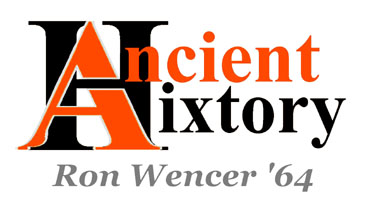
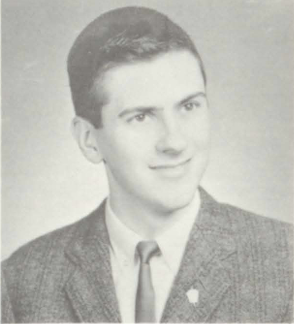
Over two centuries ago, the murky image you see headed a composite schedule of Long Island stagecoach services. It appears to depict a four-horse stage. With a bit of whimsy, the artist has placed the end of the coachman’s whip perilously close to a man's head on horseback.
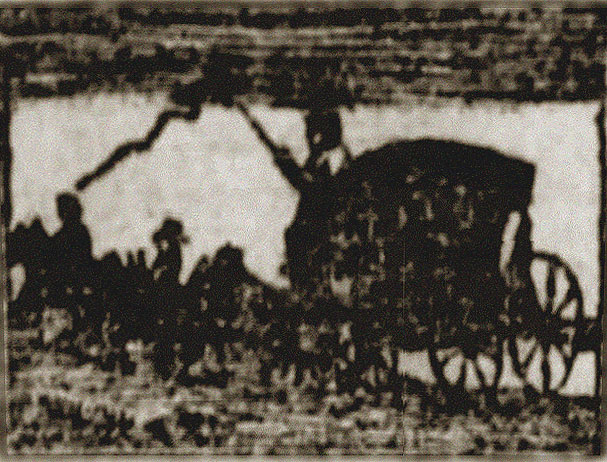 Long Island Star, July 30, 1817
Long Island Star, July 30, 1817
Mass transit consisted of stagecoaches that struggled along muddy dirt roads in those days. There was no Hicksville yet, but if you took a particular stage, you could get pretty close to where it would sprout later. Once a week, a stagecoach left Brooklyn for Jericho, and a day or two later, it returned to Brooklyn.
A Railroad With a Vision
The cities of New York and Boston were vital to the turbulent economy of the fledgling nation, but communication between them was slow. People and documents had to be carried by horse, stage, or newfangled steamboat. Railroads promised to be faster, but in the 1820s, no one thought they could conquer the shortest route – the irregular and rocky Connecticut shoreline.
The founders of the LIRR had a new vision. They intended to create a railroad of swift trains that carried important passengers (i.e., businessmen) from New York Harbor to a distant North Shore port, where they would board an LIRR steamboat bound for the New England coast just south of Boston. Bostonians would travel the same route in reverse. There would be as few stops as necessary along the way.
Many Long Island towns would get railroad stations, but only because building a station was a requisite if you wanted to lay track through a populated place. Ideally, “Boston Trains” would ignore these places because the emphasis was on fast (and profitable) end-to-end service. As far as the railroad’s stockholders were concerned, rural Islanders had been getting around for decades via stagecoach, and the stage lines could have them.
The Best Laid Tracks...
Things did not go as planned; the nationwide Panic of 1837 interrupted construction east of Westbury. The LIRR could not move people between Boston and New York with the partial infrastructure it had built, but could it get enough revenue to outlast the depression that had literally stopped it in its tracks?
The place where it had stopped was given the name HICKSVILLE, after Valentine Hicks, LIRR President. A handful of things would have to be built so that Hicksville could function as the terminus of the line from Jamaica until construction resumed:
- buildings/sheds to store tools, spare parts, oil, cleaning supplies, and dry wood (early locomotives burned it as fuel)
- a well, pump, and water tank (locomotives carried water to turn into steam)
- holding tracks (for locomotives and railroad cars not running at the moment),
- a “turnaround track” (so that locomotives at the end of the line could be turned around to point back at Jamaica)
It was Spring, and the railroad hoped that crops from farms several miles away might be shipped West to market in the summer. Passenger traffic – the local traffic it had once disdained, but paying customers nonetheless – would help, too, but a newborn town didn’t have a built-in supply of passengers. Or did it?
Cue the Coachmen
Hicksville had the railroad but no passengers. Eleven miles away (which was not “right next door” in the horse-drawn era), Huntington had no railroad, but – along with some nearby communities, like Cold Spring – it had residents who sometimes wanted to travel on the new LIRR. Soon, the railroad cooperated with the stagecoach operators it had once dismissed.
In hindsight, this was not a surprise. Since the 17th century, residents of Huntington had been in close communication with other English colonists, especially those in Amityville and Jerusalem (today’s Wantagh). Their well-worn paths had become wagon roads, and as newer settlements came to be, these wagon roads stretched and bent to accommodate them. Stagecoaches tended to follow the most-used roads. Huntingtonians long had traveled to Cold Spring and East Norwich (think Route 25A), gone on either north to Oyster Bay or south to Jericho (think Route 106), and from the latter went on to Jerusalem (think – duh – Jerusalem Avenue).
Once Hicksville... well, materialized, it took no great leap of imagination to add it as a stop for the Huntington-Jericho stage. Indeed, it was obvious that the LIRR itself got involved and soon was managing the stage operations.
Melons
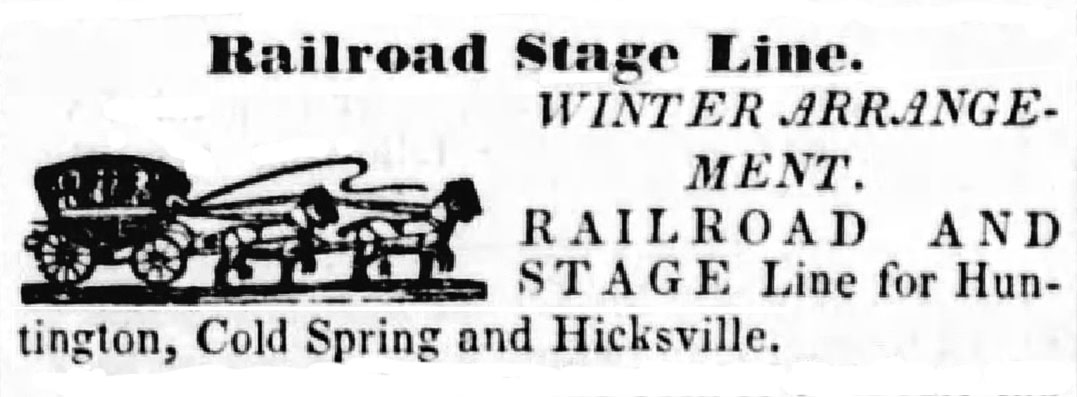 Thinking ahead: The LIRR announced its Winter stage schedule in July.
Thinking ahead: The LIRR announced its Winter stage schedule in July.
Brooklyn Evening Star, July 6, 1843
In the above announcement of the LIRR’s “Winter Arrangement,” the horses look rather like dogs, and the depiction of the coach is probably equally inaccurate. Stages of the 1840s typically were of the “melon” type, so called because their oval profiles reminded people of melons on wheels, with appendages at the front and rear. One is shown below.
Forty etchings from Sketches Made with the Camera Lucida in North America in 1827 and 1828
Captain Basil Hall, R[oyal] N[avy] Edinburgh, London, 1829
holdings of Thomas Fisher Rare Book Library, University of Toronto

The actual experience of riding in a melon was quite far removed from that of, say, Cinderella riding in her pumpkin. The sea captain who drew the sketch above, having traveled by stagecoach around much of Eastern North America, wrote this:

This account is echoed by other sources, including ones that specifically describe riding the Huntington-Hicksville stagecoach.
 Brooklyn Daily Eagle, December 18, 1909
Brooklyn Daily Eagle, December 18, 1909
From the above excerpt, one might infer that top-heavy stages sometimes overturned. They did, especially where hard-frozen, slippery mud occurred alongside a tempting ditch. The following report follows up on the continuing efforts of Hicksville’s Dr. E. G. Rave to treat injured coach passengers following the toppling of a stagecoach at Lindenhurst in 1888.
 Note: Breslau was then the name for Lindenhurst. Huntington Long-Islander (Hicksville column) December 14, 1888
Note: Breslau was then the name for Lindenhurst. Huntington Long-Islander (Hicksville column) December 14, 1888
Fame, of a Sort
Stagecoach drivers on the Island sometimes became local legends. “Uncle” Jesse Conklin drove -- and later managed – the Hicksville-Huntington stage line over a career of 50-plus years without missing a day of work. Apparently, there was more to him than his friendliness and work ethic. Oliver S. Charlick, hard-nosed President of the LIRR in the 1860s and 1870s, once famously introduced Conklin to the railroad’s Board of Directors as “the only man who ever got the best of Oliver Charlick.”
Brooklyn Daily Eagle, October 14, 1894
In addition to serving passengers on the Hicksville-Huntington route, Conklin was also the official government postal carrier between the two locales. For a time, he also drove stages between Huntington and Cold Spring for a competitor of the LIRR. These stages met the steamboat American Eagle, which in the early 1840s sailed to/from Manhattan’s Fulton Market.
After the Melon
It appears – one cannot be certain, as photographs of stagecoaches on the Island are uncommon- that the Hicksville-Huntington stage service eventually adopted a newer type of vehicle. The following drawing, included in the same article as the above portrait, shows a retired stagecoach left in a grassy field, apparently with screens in the windows. A banner strung across the rear door appears to say Huntington.
Brooklyn Daily Eagle, October 14, 1894
The elaborate paint scheme (which may have been applied by the manufacturer of the coach, as it appears on vehicles used in many different places) helped me discover some historical photographs that may give us a better idea of how this coach looked when it was in service.
5th Avenue and 33rd Street, Manhattan, c.1880
New York Historical Society Negative no. 391
(Note: This is only a portion of the entire image.)

Compared to a melon coach, this stage was of lighter construction and thus required only two horses. It looks airy and probably was quite drafty in winter.
This stage appears to be very similar to the one drawn in the newspaper article, the main difference being that this one has a clerestory projecting upward from the roof. Very popular in the 19th century, a wooden clerestory roof was meant to improve ventilation and, in the daytime, interior light levels. Over long years of service, it was prone to leak and rot and often was eventually replaced by a slightly convex or flat roof.
This image shows another possibility: a flat-roofed version with a railing to allow luggage to be carried overhead.
 Although the source dates this photograph to
Although the source dates this photograph to
1896, the woman’s dress looks a lot like 1870s fashion.
ghpl.org/timeline
from the
Grandview Heights Marble Cliff Historical Society
and Grandview Heights [Columbus, OH] Public Library
A Slow Death, and then Forgotten
Long Island’s stagecoach services were a long time dying. Years after the LIRR reached its eastern limits, many lingered. In fact, one line between Brooklyn and Freeport was still in business until at least 1907.
Given how it started, the Hicksville-Huntington line operated longer than expected: the stages ran for at least 30 years. Although the LIRR was extended to Farmingdale in 1841, a branch to Huntington was not opened until 1868. Even then, the LIRR did not technically reach Huntington. It built a station outside of town, giving rise to place-name Huntington Station. I have not been able to verify just when the Huntington-Hicksville stagecoaches ceased running, but I believe the date was in the 1880s.
Note that some of you readers may be descended from the many people who came to Hicksville in the second half of the 19th century and helped it enjoy its Golden Years. If so, your ancestors likely rode coaches to travel to the many places the LIRR never reached.
Livin' On the Edge
 by Phil Girnis (Husband of Wendy (Elkis) Girnis, '77)
by Phil Girnis (Husband of Wendy (Elkis) Girnis, '77)
My name is Phil Girnis and I lived in Hicksville on and off for forty years, before leaving Long Island in the 1980s to pursue a job opportunity out of state. My parents moved from Queens to Hicksville in the summer of 1957. I attended East Street School for the 5th and 6th grades and Hicksville Junior High for 7th and 8th. My remembrances of Hicksville life are quite different than most because of one factor: Location. We lived in the easternmost section of Hicksville. Our little development was bounded on the west by New South Rd. (adjoining the Lilco building on Old Country Rd.) and the east by South Oyster Bay Rd. I was within two or three blocks from the borders of Hicksville, Bethpage, and Plainview.
Unlike most Hicksville streets, bare lots were still on our block when we moved in. A few months after we arrived, builders started to prepare the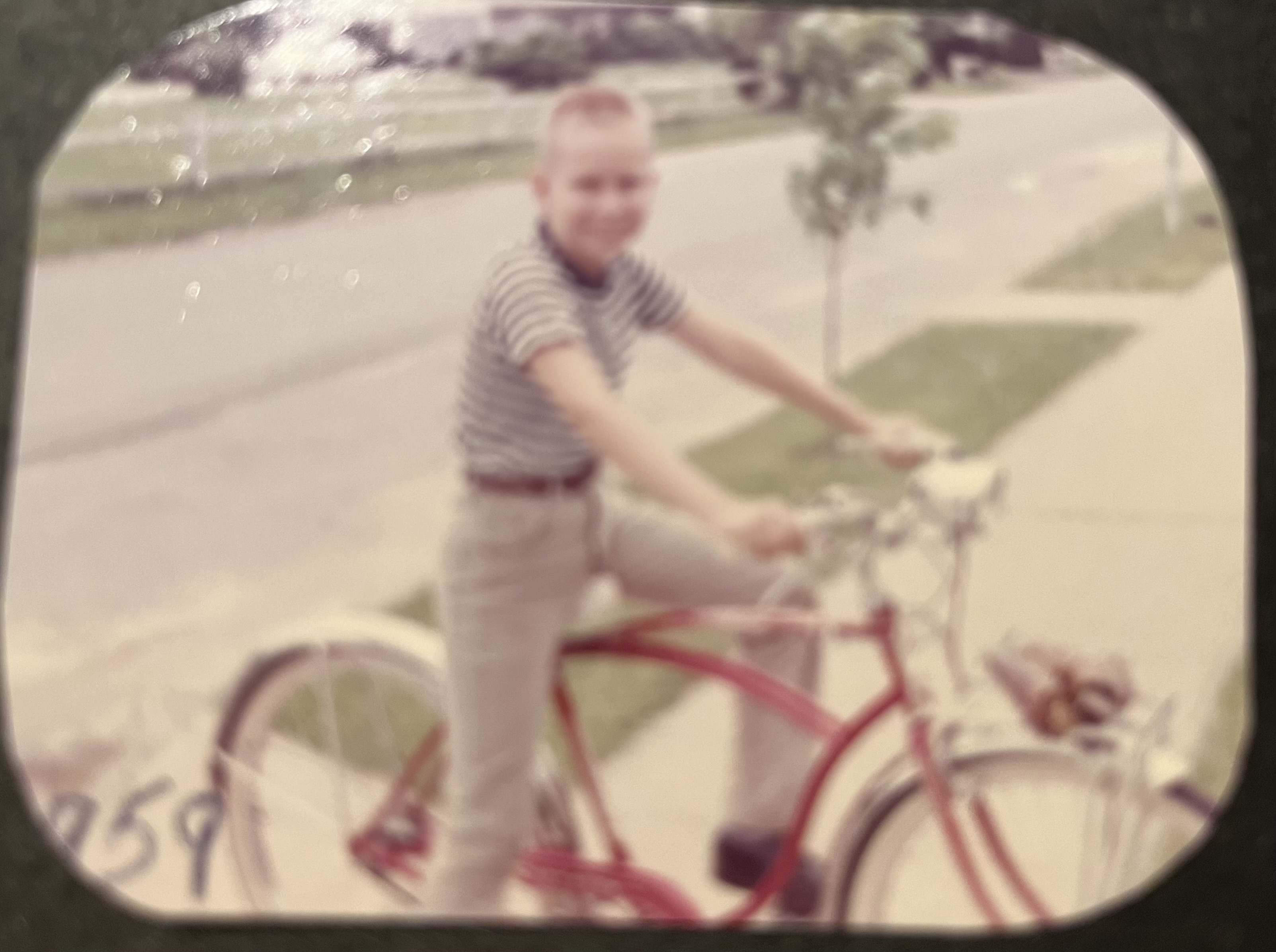 Phil Girnis with his bike 1959 on Walter Ave. two lots across the street. What happened next was a goldmine for a bunch of fifth graders. The builders dug up dirt to accommodate the foundations. That left two great holes in the ground, just perfect for bicycle stunts. We would spend all day charging down those dirt walls. Who knew that dirt biking and BMX parks originated on my block?
Phil Girnis with his bike 1959 on Walter Ave. two lots across the street. What happened next was a goldmine for a bunch of fifth graders. The builders dug up dirt to accommodate the foundations. That left two great holes in the ground, just perfect for bicycle stunts. We would spend all day charging down those dirt walls. Who knew that dirt biking and BMX parks originated on my block?
Football Games
Another weird quirk of living in my neighborhood was the choice of a park/field where we could throw the football around. Our bizzaro choice was a  "Foot Stadium" between the intersection of South Oyster Bay Rd., Old Country Rd., and Plainview Rdtiny spit of manicured land between the intersection of South Oyster Bay Rd., Old Country Rd., and Plainview Rd. We fondly called it Foot Stadium. Why we picked a little triangle of land in the middle of three busy roads to play football is beyond me, but it was OURS! A few months later, we really lucked out in regard to our football games. There were two sprawling ranch houses across the street. One was owned by the builder of our home, and the other by his cousin. Both men had sons my age. After a few months, we all became friends. This led to real football games in their backyards. Both yards together made one giant playing field.
"Foot Stadium" between the intersection of South Oyster Bay Rd., Old Country Rd., and Plainview Rdtiny spit of manicured land between the intersection of South Oyster Bay Rd., Old Country Rd., and Plainview Rd. We fondly called it Foot Stadium. Why we picked a little triangle of land in the middle of three busy roads to play football is beyond me, but it was OURS! A few months later, we really lucked out in regard to our football games. There were two sprawling ranch houses across the street. One was owned by the builder of our home, and the other by his cousin. Both men had sons my age. After a few months, we all became friends. This led to real football games in their backyards. Both yards together made one giant playing field.
The Best Part
One of the coolest parts of living in far east Hicksville was access to the Grumman property along South Oyster Bay Rd. They had at least a dozen softball fields and didn’t seem to mind if the neighbors used them. A couple of times a year, the Navy’s Blue Angels performance team would fly over the house before landing at Grumman’s airstrip. Finally, a powered model aircraft show was held by the ball fields for a few years. They had a 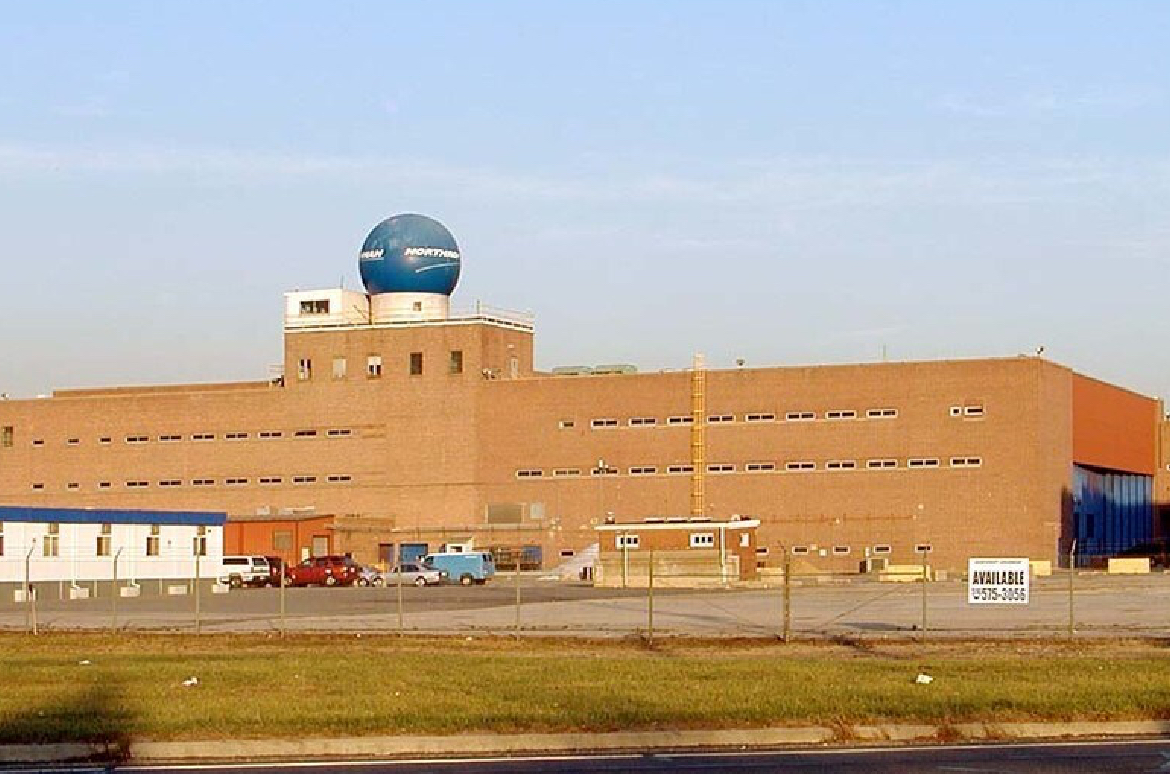 dogfight competition where streamers were tied to the tails of the aircraft and the pilots, using hand controllers would try and cut the streamers of their opponent. They would also fly reproduction radio-controlled aircraft ( mostly WWII vintage). Finally, they held an aircraft carrier landing contest. People would try to land their model planes on the beautifully handcrafted flight deck using arresting hooks and cables stretched across the deck, just like the real thing.
dogfight competition where streamers were tied to the tails of the aircraft and the pilots, using hand controllers would try and cut the streamers of their opponent. They would also fly reproduction radio-controlled aircraft ( mostly WWII vintage). Finally, they held an aircraft carrier landing contest. People would try to land their model planes on the beautifully handcrafted flight deck using arresting hooks and cables stretched across the deck, just like the real thing.
Livin' on the Edge
Like I said, growing up in the wild east end of Hicksville was definitely a different experience than your downtown Mall scene, or the West side with the Levitt homes.
More Photos...
PIXville
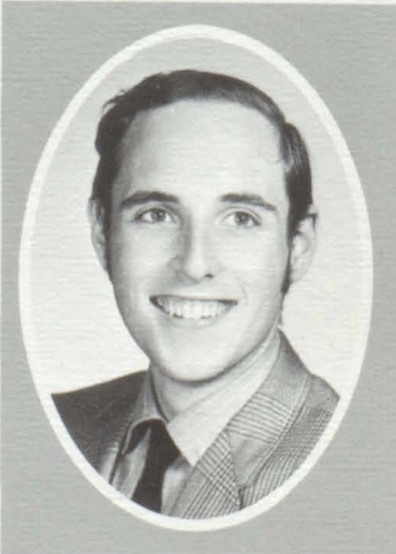 Wayne Sternberger, Class of 1971
Wayne Sternberger, Class of 1971
I graduated from Hicksville High School in June 1971. There are a few pictures of me from my time at HHS and HJHS, but they are few and far between. This was largely due to me taking pictures of everyone else. I had a couple of cameras, lots of film, and a basement darkroom. And, because this was long before the world was colorized, my photos were black and white. Fortunately for me, the memories are still in vivid color.
I was on the audio-visual squad in Jr. High and High School, so I was also behind the projector, on the PA system, and making copies of handouts and tests. I was at sporting events, pep rallies, dances, class elections, school board meetings, and other parts of our HHS existence. While we all witnessed the world changing, I had the photographic “evidence.” And I wanted to share some of that in the form of photos that I unearthed while sorting through more than 50 years of what I call collectibles and my wife (Shari Stockinger Sternberger, HHS ’71) would call clutter. These photos didn’t make it into the yearbook—for good reason—yet probably have meaning for many of us.
I suppose our parents expected school to provide academic and vocational preparation for our futures primarily. We were more likely to embrace school for the social and extracurricular activities. I want to share some of the memories I captured in the pictures I took. While they reflect a small, finite period in the history of HHS, I’m sure that HHS classmates of all ages can share the nostalgia.
Performing Arts – my umbrella for orchestra, band, chorus, and drama.
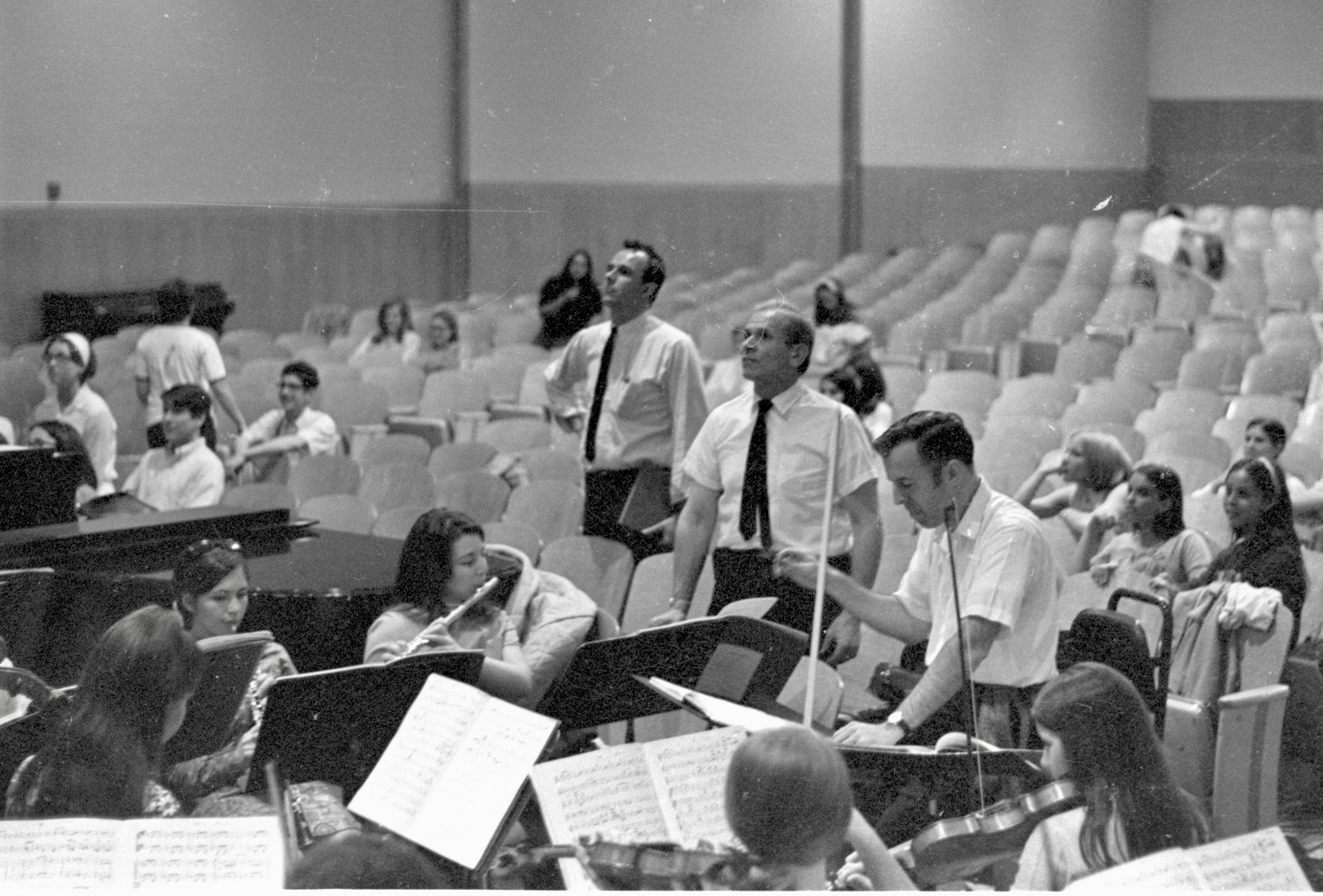 Teachers Arnold, Crucilla, & ButticeOne of my favorite shots encompasses most of the performing arts at once and captures Chuck Arnold (chorus), Joseph Crucilla (drama), and Thomas Buttice (orchestra) at a play rehearsal.
Teachers Arnold, Crucilla, & ButticeOne of my favorite shots encompasses most of the performing arts at once and captures Chuck Arnold (chorus), Joseph Crucilla (drama), and Thomas Buttice (orchestra) at a play rehearsal.
What follows are other Performing Arts photos, specifically those from music: the Stage Band, led by J. David Abt, at a concert, the marching band relaxing during an outdoor event, and miscellaneous photos. Next month, the plays will be highlighted! Take a look, and you may see someone you know or remember!
 Teacher Abt & Stage Band
Teacher Abt & Stage Band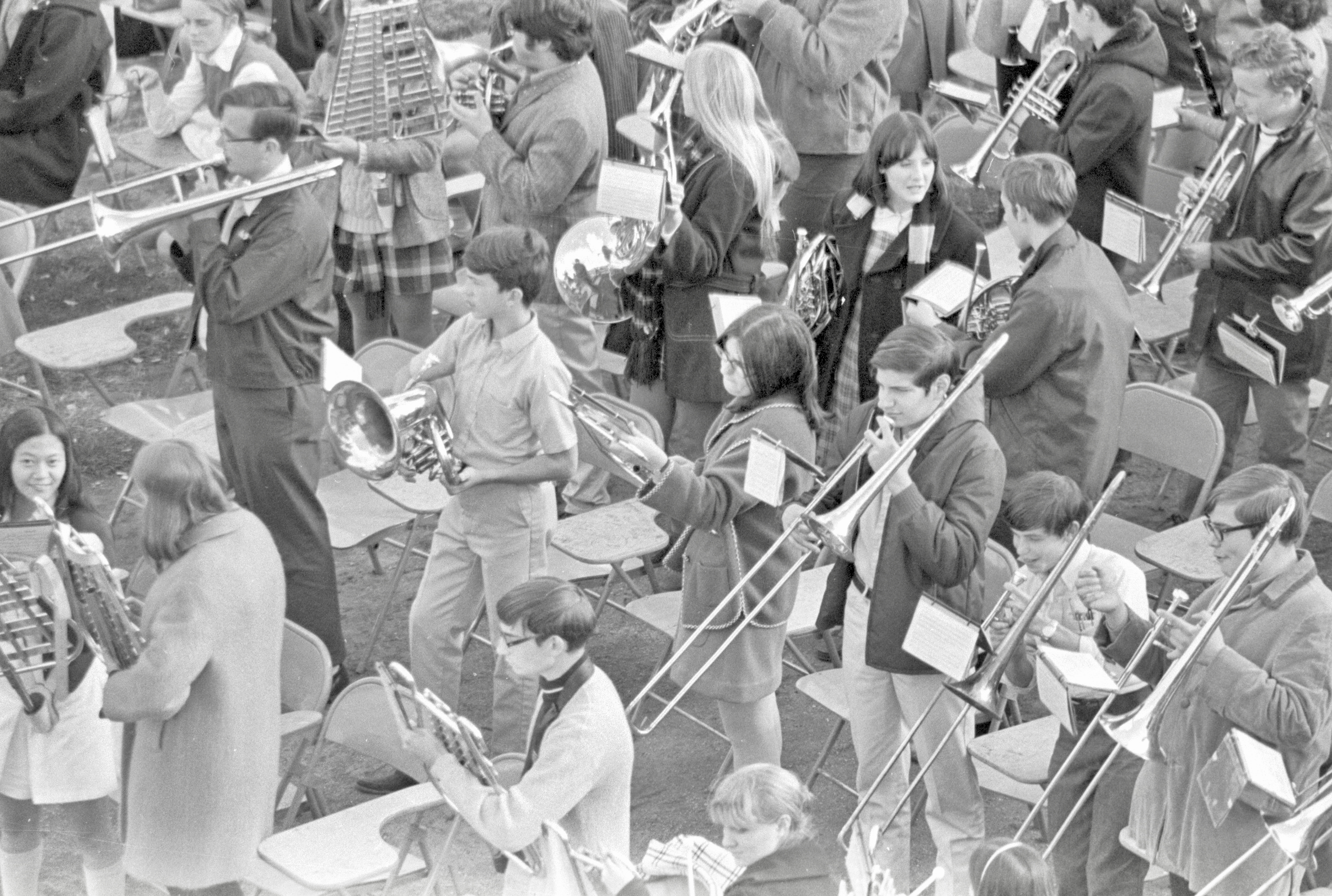 Marching Band at Outdoor Event
Marching Band at Outdoor Event
Miscellaneous Photos
Etcetera for January 2024
More News about Ethel Kunz Lehmann, HHS '47, submitted by her son Jim Lehmann
This video begins telling the story of Kid & Kubs then focuses on their super senior, Ethel.
Here is a YouTube video posted 3 years ago of NBC Today show segment that ran 20 years ago when she first joined the league.
In response to John Maniec's articles last month, Marc Malamud, HHS '77 shared this resource with us that you may find helpful: No One Should Die Alone
In Memoriam - Names are listed by class on our website. These are recent submissions. Click the name to open the obituary.
Gus Alfieri, Teacher, January 1, 2024
Mark K. Blackman, Class of 1979, December 29, 2023
Dorothy Lynn Goeb Hanifan, Class of 1974, December 28, 2023
Salvatore Mistretta, Class of 1962, January 26, 2023. In addition to the Sal's obituary, you can read an article by Ron Wencer that appeared in the You Know You're From Hicksville, NY if: Facebook group
Brian Lawrence Quinn, Class of 1976, January 6, 2024
From Facebook: This is with a very heavy heart to pass on to all that our Beloved Brother Brian has passed. He will be memorialized in Los Angeles Tuesday Jan 16 @ Pierce Brothers Westlake 2pm. Then a memorial in New York @ Our Lady of Mercy Hicksville, Monday Jan 22, 10am. Please keep our Brother Brian, Family & Friends in your thoughts and prayers. Brian was one of 9 siblings and absolutely LOVED by All. The Quinn family is in deep gratitude to Brian’s NBC Brothers, especially Cody & Lil John. Thank you
William Stepkowski, Class of 1977: Class of 77
From Joseph Long's Facebook post: Some of you may remember last year's post announcing the passing of Hicksville Class of 1977 member Bill Stepkowski. There were no traditional services arranged for Bill until now. Please join Friends Of Bill Stepkowski on Tuesday 7 PM, January 23, 2023, Double L Tavern, West Village Green. If you knew Bill from grade school, high school, playing sports, or meeting him in the breezeway, come down and raise a glass to this unique class of 77 grad.
A message from Diane Allen Romano:
Multi-Year Reunion Open for All Years
Hi Hicksville High School Graduates! Nancy Rooney and I are planning another multi-year reunion next year. The date is September 27, 2024. All are welcome. It will be from 8pm to 12am at the Milleridge Inn in Jericho. They did such a great job with the last one. It is a dinner buffet and open bar. A DJ will play music that we loved and it is multi-year. Meaning that all HHS graduates are welcome. Please share this note on any platform you think appropriate and private message me on Facebook or email me at

